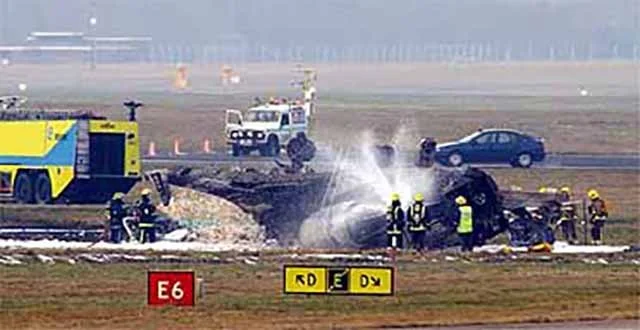Case Study: Challenger CL604 - N90AG
- James Albright (a former G450 driver)
Updated:
We used to takeoff with a good coating of ice in the T-37 and KC-135A to no ill effect because the airplanes (and crews) were expendable. Having dodged very many bullets it was easy to look at the "clean aircraft" concept with a jaundiced eye and perhaps that was the case here. But just because one airplane can take it doesn't mean the next can.
The CL-604 is incredibly sensitive to wing contamination. There was a story about a CL-604 coming out of paint with a strip of masking tape left on the forward edge of a flap causing the airplane to roll during stall maneuvers. I thought that a bit too much to believe at the time. After this mishap I believe it. And now so does the FAA, they have removed the old caveat allowing take off with ice "polished smooth." The key takeaway: you cannot ensure both wings are equal with any amount of contamination so they both have to be contamination free. (See the postscript below for expert testimony about this.
Everything here is from the references shown below, with a few comments in an alternate color.
Photo: N90AG
Accident Report
Date: 04 JAN 2002
Time: 12:07
Type: Canadair CL-600-2B16 Challenger 604
Operator: Epps Air Service
Registration: N90AG
Fatalities: 2 of 2 crew, 3 of 3 passengers
Aircraft Fate: Destroyed
Phase: Takeoff
Airports: (Departure) Birmingham International Airport (BHX) (BHX/EGBB), United Kingdom; (Destination) Bangor International Airport, ME (BGR) (BGR/KBGR), United States of America
Narrative
Challenger N90AG was prepared for a flight from Birmingham, UK to Bangor. The flight was cleared to taxi at 12:01 hrs. The captain was pilot-non-flying and was seated in the right cockpit seat. During taxi, the crew completed their normal Before Takeoff Checks; these included confirmation that the control checks had been completed and that anti-ice might be required immediately after takeoff. Flap 20 had been selected for takeoff and the following speeds had been calculated and briefed by the pilots: V1 137 kt; VR 140 kt; V2 147 kt. By 12:06, the aircraft was cleared to line up on runway 15. At 12:07 hrs, N90AG was cleared for takeoff with a surface wind of 140°/8 kt. Takeoff appeared normal up to lift-off. Rotation was started at about 146 kt. Lift-off occurred 2 seconds later, at about 153 kts and with a pitch attitude of about 8 degrees nose-up. Immediately after lift-off, the aircraft started to bank to the left. The rate of bank increased rapidly and 2 seconds after lift-off the bank angle had reached 50 degrees. At that point, the aircraft heading had diverged about 10 degrees to the left. Opposite aileron, followed closely by right rudder, was applied as the aircraft started banking; full right aileron and full right rudder had been applied within 1 second and were maintained. As the bank angle continued to increase, progressively more aircraft nose-up elevator was applied. Stick-shaker operation initiated 3.5 seconds after lift-off. The left winglet contacted the runway shoulder, the outboard part of the left wing detached and the aircraft struck the ground inverted, structurally separating the forward fuselage. Fuel released from ruptured tanks ignited and the wreckage slid to a halt on fire. The last recorded aircraft attitude was approximately 111 degrees left bank and 13 degrees nose-down pitch.
Cause
The crew did not ensure that N90AG's wings were clear of frost prior to takeoff.
Reduction of the wing stall angle of attack, due to the surface roughness associated with frost contamination, to below that at which the stall protection system was effective.
Possible impairment of crew performance by the combined effects of a non-prescription drug, jet-lag and fatigue.
Postscript
Date: 1 Nov 2014
Hello Eddie, Love this site and visit often always learning something. I'm a technician currently flying with a corporate operator in CT (GX &F900). Anyway, I've been around Bombardier A/C since the mid 90's when I worked at the BDL service center. So I always pay attn to what you write about Bombardier stuff. I couldn't believe when reading the article about the CL604 incident that you mentioned the story about the Challenger roll problem due to tape being left on the flap. I couldn't believe it because I was there and worked on that particular squawk! It's all true and I couldn't believe it at the time either. But it was not a piece of tape, It was (get this!) a paint run on the left inbd flap. It had just come out of the paint shop. We spent days going thru the rigging of those flaps even putting contour boards on the wings. I didn't see the paint run so I can't say how big it was, but I saw the area that was repainted and it was probably 6"X6". Since that incident I now take ANY imperfection on ANY part of ANY wing as something that needs to be addressed. Just wanted to let you know that its a true story. Thanks for such a great site.
If you are ever tempted to takeoff with a slight coating of ice on one wing take a look at the other wing and ask yourself if they are identically coated. Of course you have no way of knowing that. If you decide to takeoff, you have no way of knowing if your ailerons can outroll the difference in lift. This technician has said it better than I could ever hope to: your wings need to be clean prior to takeoff.
References:
Aviation Safety Network
United Kingdom Air Accidents Investigation Branch, Aircraft Accident Report 5/2004, Report on the accident to Bombardier CL-600-2B16 Series 604, N90AG at Birmingham International Airport, 4 January 2002


